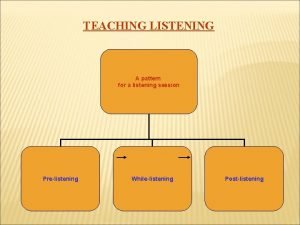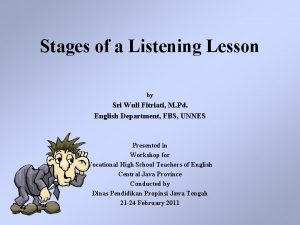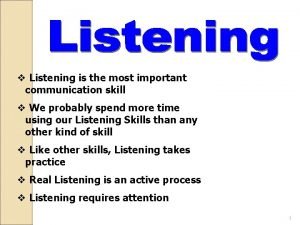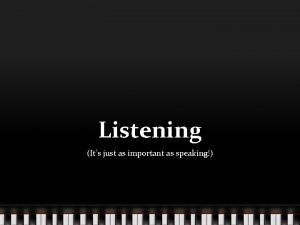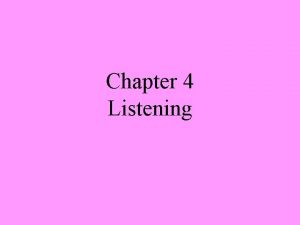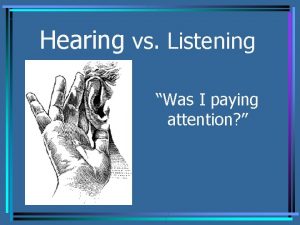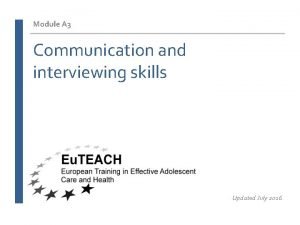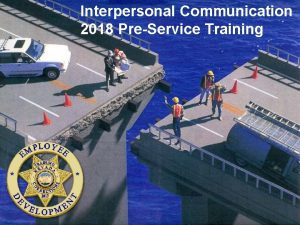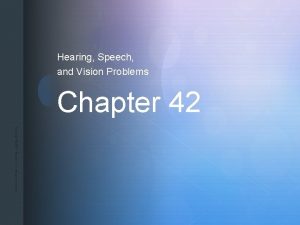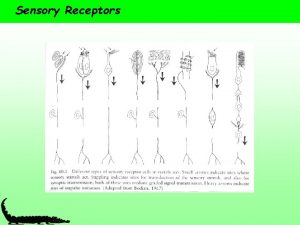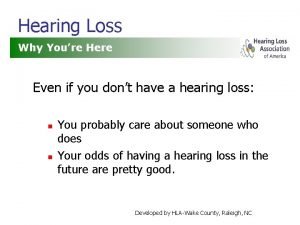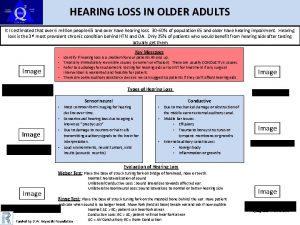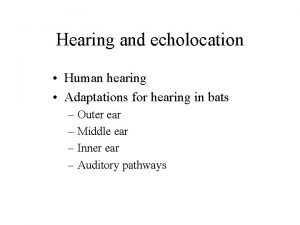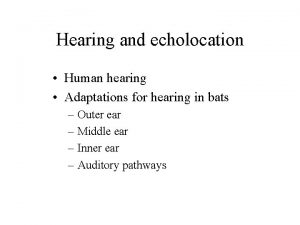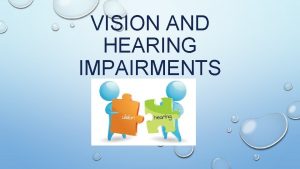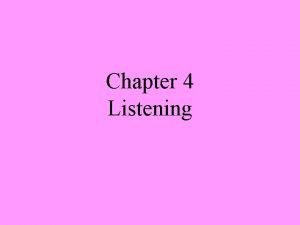Listening Chapter 3 Listening A CHOICE Hearing comes


























- Slides: 26

Listening Chapter 3

Listening: A CHOICE • Hearing comes naturally. We all HEAR. • Listening is a learned social skill. You have to DECIDE to do it. Brainstorm: 1 time when you were hearing someone but not listening to them 1 time when you forced yourself to actually listen even though you really didn’t want to 1 time when someone called you out on not listening to him or her

The Listening Process: 5 Steps • 1: Hearing—you select some sounds to focus on and tune out others. • 2: Interpreting—you decode the signals and understand the sensory input (making sense of what you hear based on what you already know) Fact: you can process almost 3 times more words per minute than people speak. • 3: Evaluating—you judge the worth or importance of something (figuring out the speakers intent based on fact & opinion).

The Listening Process: 5 Steps (Cont. ) • 4: Remembering—NOT objective. You remember what you understood based on what you perceived from what was said. • 5: Responding—you react to the speaker by sending cues. The listener sends feedback to the speaker to clarify what was heard or to take part in the conversation. • PRACTICE—take 5 minutes to tell your neighbor what you did this weekend. When it is your turn to listen, record your thought process for each of the 5 steps of listening.

Recipe for Listening: 5 Ingredients • It is important to listen for ALL 5 of the following elements when having a conversation with someone in order to fully understand him or her. • 1: Information—facts or instructions • 2: Emotion—determine what mindset the speaker has. Are they insecure or nervous? • 3: Attitude—distinguish fact from opinion • 4: Goals and Hidden Agendas—there may be messages that are not expressed directly • 5: Thoughts, Ideas, and Opinions—pay attention to omissions and nonverbal symbols, these will reveal opinions

Interview Critique: Picking out the Ingredients • Information: What is the interviewee telling you? • Emotion: Is he or she happy? Sad? Angry? Upset? WHY? • Attitude: What are the facts? What is his or her position? • Goals and Hidden Agendas: Is there a theme going on behind the words? • Thoughts, Ideas, and Opinions: What verbal and nonverbal symbols does the interviewee use to express him or herself?

ACTIVITY: Watch Interviews • George W. Bush & Kanye West ▫ Evaluate the interview for the 5 ingredients in the recipe for listening.

Listening Barriers: 4 Types • 1: External Barriers—environmental hindrances to listening ▫ Noises—can overpower message ▫ Other Stimuli—other senses reacting to events ▫ Information Overload—we tune out when there is too much coming at us • 2: Listener Barriers—psychological blocks to effective listening ▫ Boredom ▫ Laziness ▫ Waiting to speak *Opinionatedness *Prejudice *Lack of interest

Listening Barriers: 4 Types (Cont. ) • 3: Speaker Barriers—obstacles to listening that originate with the speaker ▫ Appearance ▫ Manner ▫ Power *Credibility—believability *Message • 4: Cultural Barriers—learned responses that predispose one to see things a particular way ▫ Prejudice ▫ Speaking style ▫ Source credibility *Nonverbal communication *Accents

ACTIVITY: Identifying Listener Barriers • List 7 examples of situations when you have been affected by listener barriers (list examples from home, school, work, and social situations). • Classify each situation as one or more of the six listener barriers. ▫ Boredom, laziness, waiting to speak, opinionatedness, prejudice, lack of interest • Where did most listener barriers occur? Which types were most common?

Types of Listening: 3 Types • 1: Active Listening—listening for meaning • 2: Informational Listening—listening for content and attempting to identify the speaker’s purpose, main ideas, and supporting details • 3: Critical Listening—examining information or persuasive messages and drawing conclusions SAY WHAT? !

ACTIVITY! • Brainstorm 2 different places or situations you may use or have used each type of listening. ▫ (2) Active Listening ▫ (2) Informational Listening ▫ (2) Critical Listening • Be prepared to share at least one example with the class and justify why it is that type of listening. (HINT: refer back to your definitions!)

(1) Active Listening: In-depth • There are two types of active listening. ▫ 1: Emphatic Listening– listening to discern another person’s feelings and emotions You attempt to feel the speaker’s feelings and to share his or her mood. ▫ 2: Creative Listening– receiving another’s ideas but using them to generate one’s own creative ideas You use creative listening in brainstorming sessions by building off of other’s ideas.

(1) Active Listening Process: 5 Steps • 1: Find and organize the speaker’s main ideas. ▫ Use logic! • 2: Mentally summarize what the speaker is saying. ▫ Put a message into your own words! • 3: Echo the speaker’s meaning. ▫ Repeat what you think you heard! • 4: Echo the speaker’s expressed or implied feelings ▫ Watch your perceptions! • 5: Ask questions to receive further clarification. ▫ Show interest and support!

(1) ACTIVITY! Active listening in tough conversations • Role-Play: ▫ Speaker— BE DIFFICULT! BE A PAIN! ▫ Listener— Attempt to actively listen and empathize/sympathize with the speaker. Pay attention to emotions and ideas. ▫ Observers— Is the active listener being successful in picking up on the emotions and concerns of the speaker?

(2) Informational Listening: In-depth • When informational listening is important: ▫ ▫ ▫ Classroom settings Work training sessions Receiving directions Traveling Interviews • How to improve understanding when practicing informational listening: ▫ Take good notes!

(2) Informational Listening: ACTIVITY • When your informational listening skills FAIL you: ▫ Brainstorm at least 3 times in your life when you have failed in the informational listening department. What did you do to fix it? ▫ Turn & Talk: share your fails with your neighbor and compare your situations.

(3) Critical Listening: In-depth • Pay attention to the following 5 areas when listening critically: ▫ 1: Source Credibility– who is speaking, and how believable is he or she? ▫ 2: Attitude—is the speaker respectful or condescending to the listener? ▫ 3: Speaker’s Goal—why is the speaker trying to persuade me? Is he or she repeating anything? ▫ 4: Content—What is the main idea? What evidence is presented? Is the conclusion logical? ▫ 5: Reasoning—are the ideas presented well-supported?

(3) Critical Listening: Faulty Reasoning • Inductive Reasoning: identifying facts and linking them together to support a specific conclusion • Logical Fallacies: false methods of reasoning

(3) Critical Listening: 7 Common Logical Fallacies • 1: Begging the Question: speakers assume the truth or falsity of a statement without supplying proof. • 2: Card Stacking: speakers select only the evidence and arguments for the side that they support. • 3: False Premises: speakers begin with false assumptions that are assumed to be true. • 4: Glittering Generalities: speakers use vague or general words or phrases that express an attitude or idea that has popular support.

(3) Critical Listening: 7 Common Logical Fallacies • 5: False Generalizations: speakers don’t have enough evidence to support a broad conclusion, or they selectively leave out details and come to a quick conclusion. • 6: Non Sequitur: speakers assert something that doesn’t follow logically or that deals with a completely different subject. • 7: Testimonial: speakers use an authority or a well-known person to endorse a particular subject or position to gain the listener’s approval.

ACTVITY! Research. • Research one of the 7 common logical fallacies. • In your presentation to the class you will… ▫ present the definition (same or reworded) ▫ present at least one example that you found each person must talk at least once

(3) Critical Listening: 7 Propaganda Techniques • Propaganda: a form of persuasion that discourages listeners from making an independent choice by stating opinions as though they are accepted truths.


(3) Critical Listening: 7 Propaganda Techniques • 1: Transfer: makes an illogical connection between unrelated things • 2: Bandwagon: encourages listeners to join a group that favors a particular person, product, or idea because it is popular • 3: Name Calling: uses a negative term to refer to a group or an idea without providing evidence or proof • 4: Loaded Words: uses language that evokes strong feelings and attitudes in the listener to sway an argument

(3) Critical Listening: 7 Propaganda Techniques • 5: Emotional Appeals: assumes that the listener shares the emotional responses of the speaker • 6: Stereotypes: applies preconceived notions to a person based on his or her membership in a group • 7: Either/Or: poses arguments between two opposite choices, failing to take into account other possibilities
 Pre listening while-listening and post listening
Pre listening while-listening and post listening Pre listening stage
Pre listening stage Active listening vs hearing
Active listening vs hearing Importance of listening
Importance of listening Listening vs hearing
Listening vs hearing Listening vs hearing
Listening vs hearing Hearing vs listening
Hearing vs listening Tuning out dull topics
Tuning out dull topics Listening
Listening Factual distractions
Factual distractions Family
Family Listening vs hearing
Listening vs hearing Proxemics in communication skills
Proxemics in communication skills First comes love, then comes marriage
First comes love, then comes marriage Good choice or bad choice
Good choice or bad choice Chapter 42 hearing speech and vision problems
Chapter 42 hearing speech and vision problems Active vs passive listening
Active vs passive listening What does critical listening mean
What does critical listening mean Vertebrate sensory receptors
Vertebrate sensory receptors Why does paris fight romeo? *
Why does paris fight romeo? * Hearing on advisement
Hearing on advisement Hearing personalauswahl
Hearing personalauswahl Spatial agreement asl
Spatial agreement asl Otomycosis icd 10
Otomycosis icd 10 Safetymri
Safetymri Cookie bite hearing loss
Cookie bite hearing loss Conductive hearing loss lateralization
Conductive hearing loss lateralization
